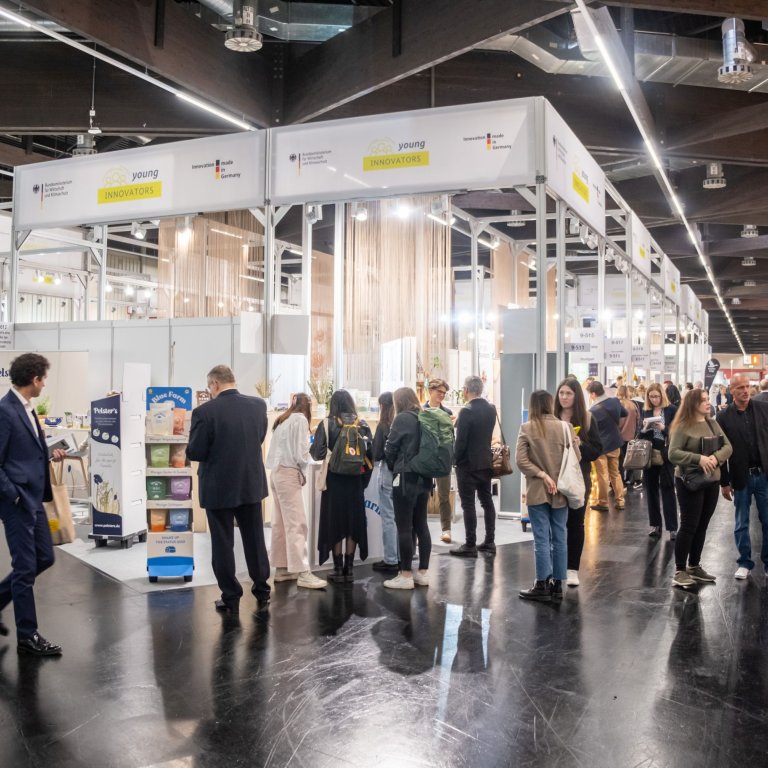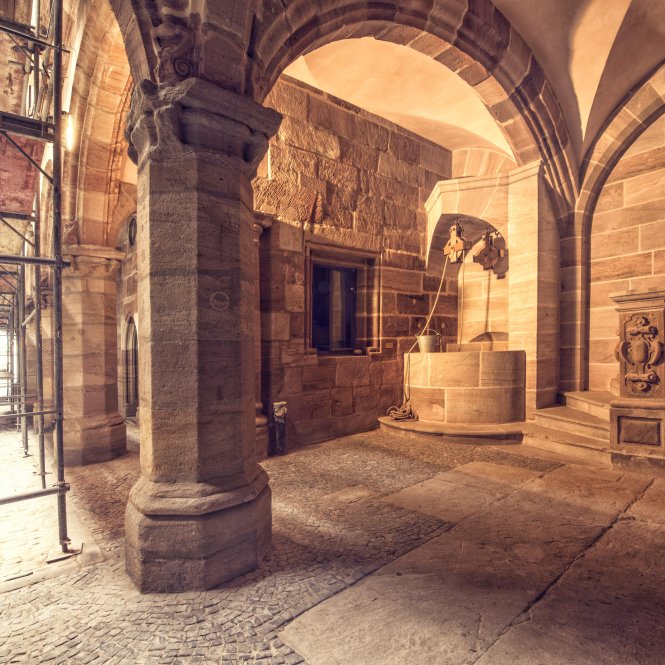

How stonemasons recreate Nuremberg's once most magnificent house.
Hidden in a Nuremberg backyard, craftsmen have been working for almost ten years to revive Renaissance architecture. Invisible from the street, they are reconstructing stone by stone the magnificent courtyard galleries of the Pellerhaus, a Venetian-inspired merchant's residence dating from 1605. We spoke to the two stonemasons Roland Meier and Harald Pollmann about craftsmanship, perseverance and Nuremberg beauties.
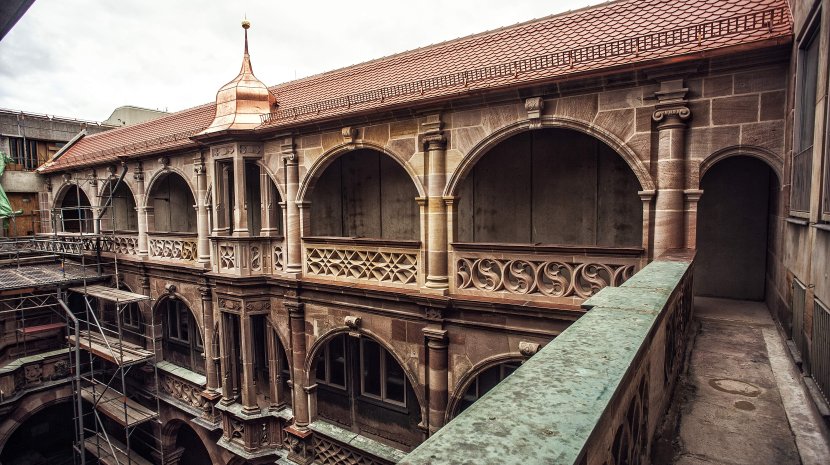
Beautiful stonemasonry: reconstructed choir in Nuremberg's Pellerhof.
The Pellerhaus is pure Renaissance glamour. Very few private buildings in the 17th century north of the Alps were as impressive as 'Nuremberg's most beautiful house'. It is the home of the wealthy upstart Martin Peller. The fortunate merchant had the residence built by master builder Jakob Wolff the Elder in 1602-1607.
After the destruction of Nuremberg in the Second World War, little remained of the city residence's showpieces. But at least enough to keep Nurembergers' desire for the old splendour ablaze. A private initiative finally got the reconstruction of the inner courtyard rolling in 2005. At that time, stonemason Harald Pollmann was actively involved. Together with his colleague Roland Meier, stone technician/master stonemason and head of the natural stone department of the construction company GS Schenk, he is still intensively involved in the reconstruction today.
Mr. Meier, Mr. Pollmann, how often does a stonemason get his hands on a project like the reconstruction of this historic arcaded courtyard?
Pollmann: Probably once in a lifetime. If you're lucky. This project is really unique.
Meier: Even though we have already done quite a bit of restoration work, for example on the Nuremberg Imperial Castle or the Cadolzburg with its elaborate ribbed arches - the Pellerhof is something very special in terms of the scope and variety of the ornamentation.
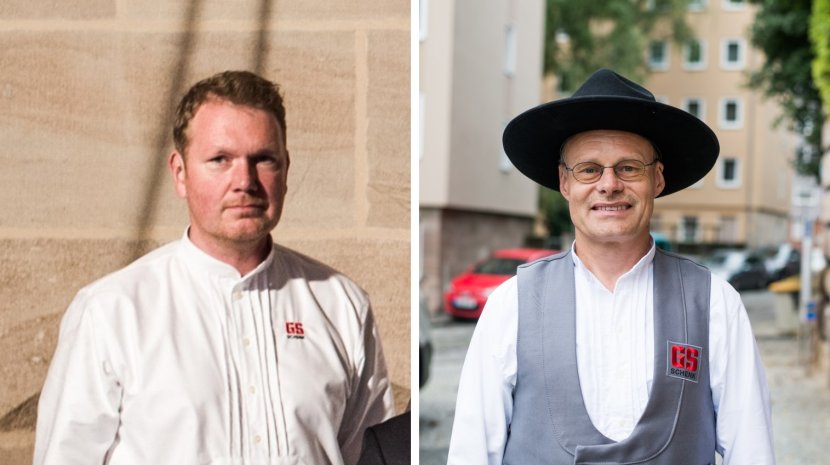
Stonemason Harald Pollmann (left), master stonemason and stone technician Roland Maier.
Mr. Pollmann, in 2005 you simply went ahead and symbolically gave the city four stones for a balustrade. That got the reconstruction rolling. How did it continue until today?
Pollmann: First of all, from 2008 onwards, it was our task to secure the existing building. The arches on the ground floor and the arcades on the first floor were still standing. Then we really got started with the fountain on the ground floor and the stairs. The next construction phase concerned the second floor. Here, only the outer arcade arches were still standing. We were able to complete the third construction phase in 2016 - we rebuilt the entire second floor of the inner courtyard. The next and final phase of construction is the gable of the north façade. For this, I am currently making the drawing reconstruction on a scale of 1:1.
Meier: Because the reconstruction is financed purely by donations, we are proceeding in sections.
What kind of stone are you using?
Meier: We are using quartzite sandstone from the Worzeldorfer Bruch here in Nuremberg. It's the same stone that was used in the restoration of the Pellerhaus in the 1930s. This creates a homogeneous, natural impression between old and new.
Pollmann: The great thing for me as a stonemason is: at the Pellerhof we do the whole process from quarrying the raw stone in our own quarry, to the planning sketches, to the filigree detail work and the setting of the stone. It just goes to show what an incredibly versatile profession it is!
Unlike the stonemasons in the early 17th century, today you have technical support. At the Stone+tec natural stone trade fair in Nuremberg, for example, there is a huge range of technology, from small pneumatic hammers to computer-controlled stone cutters as high as a house. What machines do you use for the Pellerhof?
Meier: We cut the material from the quarry to size with a large circular saw into a six-sided saw piece, which then lands on the stonemason's workbench. From then on, all the stones are hewn only by hand, using technical aids such as pneumatic hammers, of course. But automatic milling machines or the like are simply not worthwhile here, because we cannot do series production: With the Pellerhaus, every stone is different. Even seemingly regular shapes have many differences in detail. We recreate this with great precision and this contributes to the authentic impression.
Pollmann: You may not be able to see the fine differences in detail, but I firmly believe that you can feel it when you look at it: this building, this stone didn't just fall out of a machine, it's all handmade.
That certainly takes time ...
Meier: Let's take the tracery in the inner courtyard, the "railing" between the arcades, so to speak: One stone, about one meter long, takes two to three weeks of work! Moving it to the right place in the courtyard then takes one or two hours.
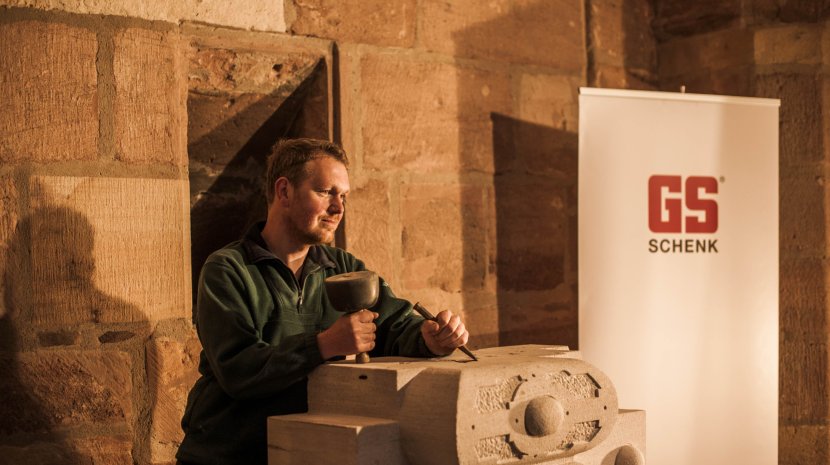
Handwork on every stone: Harald Pollmann presents his skills.
How much does the Pellerhof tie up the stonemasonry team of GS Schenk? After all, the reconstruction has been going on since 2008 ...
Meier: That depends on the work in hand. In the planning phases or in the summer months, when we are very busy with other construction sites, it's a one-man program. Otherwise, there are usually two of us working on it, and at peak times even six or seven men! Two to three weeks of work go into one metre of stone.
Two to three weeks of work go into one metre of stone.
There hasn't been a similarly extensive restoration project in the region since the 1950s. What do you take away from such a task?
Meier: We have already grown with this project. If you look very closely, you might see that the west side was a little easier for us than the east side, which we started with. In this respect, it's good that the most complicated section, the north façade, is now coming to an end ...
Pollmann: On guided tours of the Pellerhof, people are always amazed that anyone can still do something like this today. To this I can only say: But of course we can! Actually, every stonemason should be able to do something like that. You just have to give us the right orders! (laughs)
Nuremberg has a long tradition of trade, as evidenced by the Pellerhaus as a merchant's residence. And Nuremberg has also been a centre of handicrafts since the Middle Ages. What highlights do you recommend to visitors interested in stonemasonry?
Meier: There are so many things - but the Nuremberg churches are particularly spectacular. The sacrament box in Nuremberg's Lorenzkirche is simply astonishing. This filigree pinnacle curving upwards... even as a professional you stand in front of it and wonder how they did it!
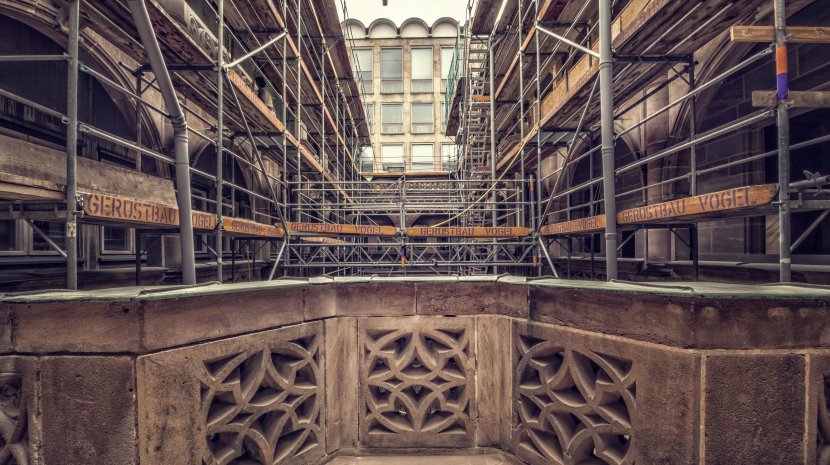
The restoration of the courtyard complex is expected to cost around three million euros in total.
The restoration of the Pellerhof
The Pellerhof is located behind the modern-objective façade of today's Pellerhaus from the 1950s at Nuremberg's Egidienplatz, which was also designed with a lot of natural stone. The reconstruction of the courtyard is financed by the association Altstadtfreunde Nürnberg from donations. Further information and pictures at www.altstadtfreunde-nuernberg.de and on the project page of the company GS Schenk.
Image credits:
© GS SCHENK GmbH



